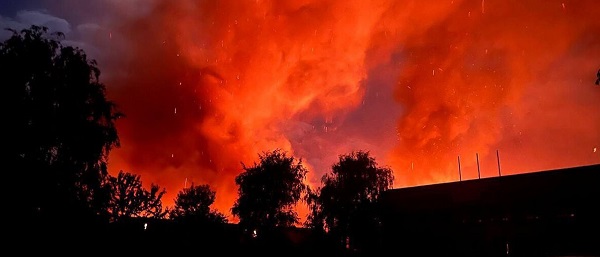conflict
Over 200 Days Into War, Family Of American Hostage in Gaza Strives For Deal To Bring Son Home

 From the Daily Caller News Foundation
From the Daily Caller News Foundation
By JAKE SMITH
The parents of an American-Israeli hostage in Gaza are doing everything in their power to bring him back home since the Israel-Hamas war began more than 200 days ago, they told the Daily Caller News Foundation.
Edan Alexander, 20, is one of five American hostages currently being held by Hamas in the Gaza Strip. His parents, Adi and Yael, have been meeting with U.S. and Israeli officials to discuss how to get him home as international negotiators rush to reach a deal with Hamas that would see the release of hostages in exchange for a temporary ceasefire.
“They’ve been constantly optimistic for months now since the beginning of January, and I know that they keep negotiating, although Hamas, sometimes they’ve stopped negotiating,” Adi told the DCNF. “But right now it feels like it’s a perfect storm. And everything needs to come kind of together. Even if it’s a small humanitarian deal that can open the gate for the bigger deal, we need to start with that. Just to kind of strike the first small deal.”
There are approximately 128 hostages being held by Hamas, including Israeli and foreign civilians and Israel Defense Forces (IDF) soldiers.
The current proposal being negotiated would see a 40-day ceasefire in exchange for up to 33 hostages currently in Hamas captivity, with the possibility of a longer-term ceasefire should both sides uphold the deal, The Wall Street Journal reported on Friday. The following phases of the ceasefire could possibly extend up to a year.
Edan was born in Tel Aviv and brought to the United States before his first birthday, growing up mostly in New Jersey, Yael and Adi told the DCNF. He joined the IDF after graduating from high school and was serving at a small base near the border of Gaza when Hamas attacked Israel on Oct. 7, killing 1,200 people and kidnapping hundreds of others.
“Before 7 a.m., he’s calling me. And he was yelling, ‘Mom. It’s like a war here. I’m seeing terrible stuff. You cannot believe what I’m seeing,” Yael told the DCNF. “And then I’m like, you’ll be ok, you just protect yourself. You will be okay … I told him that I love him. And that’s it. This is the last time that I heard him.”
Israeli intelligence later contacted Yael and Adi and told them Edan had been among those kidnapped during the attacks, showing them bodycam footage recovered from Oct. 7 depicting him being arrested and taken by Hamas operatives, the parents told the DCNF.
Yael and Adi have since spent their time raising awareness about their son and the hostages in news conferences and rallies with the other hostage families.
“We met with President Biden twice, with Vice President Kamala Harris twice, and numerous times with [White House National Security Advisor] Jake Sullivan and with [CIA Director] Bill Burns,” Adi told the DCNF. Yael added that they have a weekly update call with the State Department.
Yael has also met with Israeli Prime Minister Benjamin Netanyahu, and the family speaks with Israeli officials when visiting the region. Conversations on the Israeli side are highly sensitive and guarded to ensure vital information isn’t leaked, they told the DCNF.
“We try to keep them private and yes, a lot of confidential things are being shared there. So it’s a little bit different,” Adi told the DCNF. “It’s also that the Israelis have to have bigger fish to fry.”
Though Hamas has previously rejected several proposals, there’s some hope on the U.S. and Israeli side that they’re closing in on reaching a deal, Yael and Adi told the DCNF. Sullivan told MSNBC during an interview on April 26 that there was “new momentum” in negotiations.
Having shared the common struggle of knowing their relatives are being held by a terrorist organization in currently one the most deadly places in the world has brought many of the families closer together, Yael and Adi told the DCNF.
“It’s unreal, all the stories and everything. All the families now we are like all together, and we’re like big family, these people that I never met before, and now I’m feeling the connection with them,” Yael told the DCNF. “I just want to spend time with them because they get it.”
Yael and Adi told the DCNF that, above all, they are looking forward to their son coming home so that the family can resume some sense of normalcy. Adi joked that they’d take a trip to the Bahamas and help Edan start applying for colleges.
“I don’t think I’m gonna stop holding him,” Yael said.
Artificial Intelligence
AI Drone ‘Swarms’ Unleashed On Ukraine Battlefields, Marking New Era Of Warfare


From the Daily Caller News Foundation
Artificial intelligence-powered drones are making their first appearances on the battlefield in the Russia-Ukraine war as warfare creeps closer to full automation.
In bombardments on Russian targets in the past year, Ukrainian drones acting in concert were able to independently determine where to strike without human input.
It’s the first battlefield use of AI “swarm” technology in a real-world environment, a senior Ukrainian official and Swarmer, the company who makes the software, told the Wall Street Journal in a Tuesday report. While drones have increasingly defined modern battlefields, swarms until now had been confined to testing rather than combat.
“You set the target and the drones do the rest,” Swarmer Chief Executive Serhii Kupriienko told the WSJ. “They work together, they adapt.”
So far, the Swarmer technology has been used hundreds of times to target Russia assets, but was first used a year ago to lay mines on the front, the Ukrainian official told the WSJ. The software has been tested with up to 25 drones at once, but is usually utilized with only three.
Kupriienko told the WSJ that he was preparing to test up to 100 drones at once with the linking software.
A common arrangement used on the battlefield includes one reconnaissance drone to scout out the target and two explosive drones delivering the payload on target, the official told the WSJ.
While Western nations such as the U.S., France and the United Kingdom are also pursuing drone swarm technology, they have not deployed swarm technology on the battlefield the way Ukraine has, according to the WSJ. Currently, autonomous weapons are not regulated by any international authority or binding agreement, but ethical concerns around the technology has led many to call for increased regulation of weapons like the Swarmer system.
The Ukrainian Ministry of Foreign Affairs did not immediately respond to the Daily Caller News Foundation’s request for comment.
conflict
Trump Pentagon Reportedly Blocking Ukraine From Firing Western Missiles Deep Into Russia


From the Daily Caller News Foundation
The Department of Defense has spent months blocking the Ukrainian military from using American and British-made missiles to hit targets deep inside Russia, The Wall Street Journal reported Sunday, citing unnamed U.S. officials.
Undersecretary of Defense for Policy Eldridge Colby reportedly designed the procedure to review requests to carry out the long-range strikes with weapons that are either of U.S. origin or that require American intelligence or use components provided by the U.S., according to the WSJ. Secretary of Defense Pete Hegseth reportedly has the final say on whether Ukrainian forces can use the MGM-140 ATACMS (Army Tactical Missile System) to hit targets in Russia.
The reported blocks on missile strikes coincides with a Trump administration effort to broker a peace deal between Russia and Ukraine. A Pentagon spokesperson declined to comment further on the matter.
BREAKING: President Vladimir Putin reacts to B-2 Flyover pic.twitter.com/1mzVn7DxlW
— Jack Poso 🇺🇸 (@JackPosobiec) August 15, 2025
The Biden administration allowed Ukraine to carry out strikes with ATACMS in November, weeks after President Donald Trump won the 2024 election, the New York Times reported. Trump criticized the move during a December interview with Time magazine.
“It’s crazy what’s taking place. It’s crazy,” Trump said. “I disagree very vehemently with sending missiles hundreds of miles into Russia. Why are we doing that? We’re just escalating this war and making it worse. That should not have been allowed to be done.”
Trump and Russian President Vladimir Putin met in Alaska on Aug. 15 for a summit meeting during which Trump sought to secure a cease-fire in Russia’s war with Ukraine. As Trump greeted Putin, a B-2A Spirit stealth bomber and several fighters carried out a flyover of Elmendorf Air Force Base.
Trump met with Ukrainian President Volodymyr Zelensky and major European leaders on Aug. 18 to update them on the summit.
In July, Trump reached an agreement with NATO where members of the alliance would purchase weapons, including MIM-104 Patriot surface-to-air missiles, and donate them to Ukraine.
-

 International1 day ago
International1 day agoAustralian PM booed at Bondi vigil as crowd screams “shame!”
-

 Business2 days ago
Business2 days agoThere’s No Bias at CBC News, You Say? Well, OK…
-

 Uncategorized1 day ago
Uncategorized1 day agoMortgaging Canada’s energy future — the hidden costs of the Carney-Smith pipeline deal
-

 Opinion2 days ago
Opinion2 days agoReligion on trial: what could happen if Canada passes its new hate speech legislation
-

 Automotive20 hours ago
Automotive20 hours agoCanada’s EV gamble is starting to backfire
-

 Alberta16 hours ago
Alberta16 hours agoAlberta Next Panel calls to reform how Canada works
-

 Digital ID7 hours ago
Digital ID7 hours agoCanadian government launches trial version of digital ID for certain licenses, permits
-

 Agriculture17 hours ago
Agriculture17 hours agoEnd Supply Management—For the Sake of Canadian Consumers



